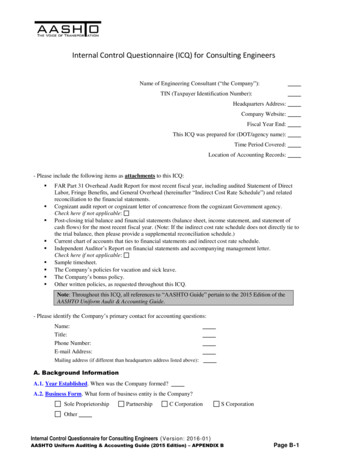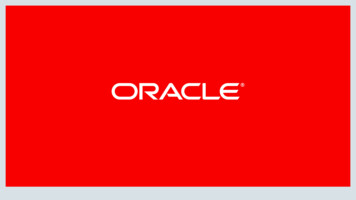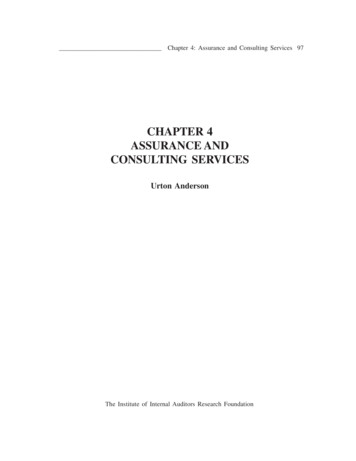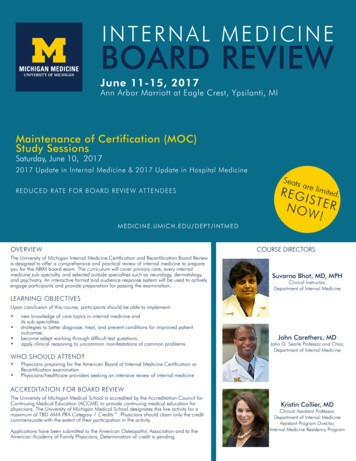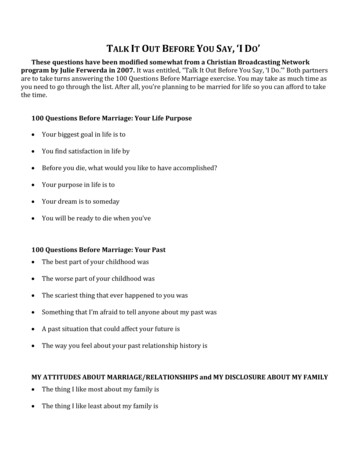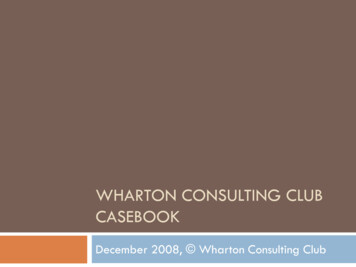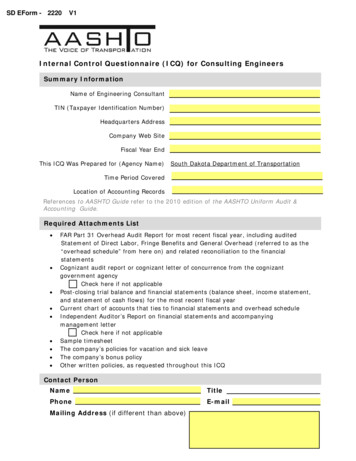
Transcription
SD EForm - 2220V1Complete and use the button at the end to print for mailing.Internal Control Questionnaire (ICQ) for Consulting EngineersSummary InformationName of Engineering ConsultantTIN (Taxpayer Identification Number)Headquarters AddressCompany Web SiteFiscal Year EndThis ICQ Was Prepared for (Agency Name)South Dakota Department of TransportationTime Period CoveredLocation of Accounting RecordsReferences to AASHTO Guide refer to the 2010 edition of the AASHTO Uniform Audit &Accounting Guide.Required Attachments List FAR Part 31 Overhead Audit Report for most recent fiscal year, including auditedStatement of Direct Labor, Fringe Benefits and General Overhead (referred to as the“overhead schedule” from here on) and related reconciliation to the financialstatementsCognizant audit report or cognizant letter of concurrence from the cognizantgovernment agencyo Check here if not applicablePost-closing trial balance and financial statements (balance sheet, income statement,and statement of cash flows) for the most recent fiscal yearCurrent chart of accounts that ties to financial statements and overhead scheduleIndependent Auditor’s Report on financial statements and accompanyingmanagement lettero Check here if not applicableSample timesheetThe company’s policies for vacation and sick leaveThe company’s bonus policyOther written policies, as requested throughout this ICQContact PersonNameTitlePhoneE-mailMailing Address (if different than above)HELP
A. Background Information1. When was the company formed?2. What kind of business is it?Sole ProprietorshipPartnershipC CorporationS CorporationOther:3. Is the company a subsidiary of another company?YNIf yes, please explain:4. Does the company own or control any other company through common ownership?(See AASHTO Guide Section 8.23B for details.)YN5. List the major stockholders, partners or other owners with greater than 5 percentownership of the company and their respective percentages of ownership.NameTitleOwnership %6. What types of services does the company provide? (e.g., consultant-architecturaland engineering design)7. How many offices does the company operate, and where are these offices located?8. How many employees, including managers and principals, does the companycurrently employ?Full timePart time9. For the most recent fiscal year, what percentage of the company’s revenue wasgenerated from each of the following?a. State governmentc. Local government%%b. Federal governmentd. Commercial/private%%10. What percentage of company revenue was generated from these contract types?a. Lump sumc. Cost plus (time and materials)%%b. Cost plus fixed feed. Other: (Please explain below.)Internal Control Questionnaire for Consulting EngineersAASHTO Uniform Auditing & Accounting Guide%%2
B. Accounting: General Background1. Has the company used the same fiscal reporting period for the past twoyears?YN2. What basis of accounting does the company use to prepare general purposefinancial statements?CashAccrualHybrid. If hybrid, please explain:Was the same basis of accounting also used to prepare the firm’s overheadschedule?YNIf no, please explain:3. Does the company have written accounting policies that address thefollowing topics? If yes, please provide a copy.YNa. Accounting system .YNb. Billing .Nc. Cost estimating allowability . YYNd. Bonus policy .Ne. Recording time worked/timesheet preparation . YYNf. Fringe benefits/leave time .Ng. Recording overtime. YYNh. Compliance with FAR Part 31* and applicable CAS .YNi. Recording direct and indirect cost rate development .Nj. Overhead/indirect cost rate development . YYNk. Billing rate development .*FAR Part 31 is codified at 48 CFR Part 31, available at www.arnet.gov/far.4. How frequently does the company prepare an overhead schedule todetermine costs eligible for reimbursement per FAR Part 31?AnnuallyOther. Please specify:Is the schedule prepared by the company or by another entity (e.g., CPAfirm)?Internal staffExternal party. Please specify:Period covered by most recent overhead schedule (e.g., “one-year fiscalperiod ended Dec. 31, 20xx”).5. Is management aware of any material instances of fraud, illegal acts, abuseor violations of contract provisions or grant agreements?YNIf yes, please explain:6. Are appropriate personnel with the company familiar with FAR Part 31?YNIf no, please explain:Internal Control Questionnaire for Consulting EngineersAASHTO Uniform Auditing & Accounting Guide3
7. Within the past 3 years, has a CPA or governmental agency performed anindependent audit, review, attestation or compilation of the company’sfinancial data or any phase of the company’s operations?YNIf yes, complete the following, if applicable:a. Financial Other:Name of CPA or AgencyContactPeriod Coveredb. Overhead Rate:AuditReviewWas the overhead rate calculated in accordance with FAR Part 31?YNName of CPA or AgencyContactPeriod Coveredc. Project AuditsAuditReviewCompilationOther:Name of CPA or AgencyContactPeriod CoveredC. Accounting Systems1. What type of accounting software does the company use?Internally developedCommercial system:Please describe any significant manual procedures used outside of theautomated accounting system to record transactions:2. Does the company have a job-cost accounting system?YNIf no, please explain what type of system is used:3. Does the general ledger interface with the job-cost ledger?N/A (No job-cost ledger used.)YNInternal Control Questionnaire for Consulting EngineersAASHTO Uniform Auditing & Accounting Guide4
4. Which of the following types of records does the company maintain to supportfinancial transactions?YNa. General ledger .Nb. Cash disbursements journal . YYNc. Cash receipts journal .Nd. Job/project-cost ledger . YYNe. Labor distribution reports .Nf. Employee expense reports . YNg. Payroll registers . Y5. Does the general ledger contain separate direct and indirect accounts for thefollowing?YNa. Labor costsb. Nonlabor expenses YNIf no, please explain:6. Does the company have a system in place to identify and remove from theindirect cost pools all unallowable costs, in accordance with FAR Part 31 andapplicable Cost Accounting Standards? (See AASHTO Guide sections 2.2, 4.4,5.2, 5.5 and 6.3.)YNIf yes, please answer a-c below:a. Please provide details about the system:b. How are appropriate personnel trained to distinguish between allowableand unallowable costs?c. When does the review for allowability occur—at the time the transaction isrecorded, or later?7. Does the company have more than one division/cost center?YNIf yes, are separate ledgers maintained for each?YNComment:8. Does the company reconcile the financial accounting system to the job-costsystem?YNN/AIf yes, how often? Check all that applyMonthlyQuarterlySemi-annuallyIf no, please explain:Check here if systems are integrated:(No job-cost ledger used.)Annually9. How frequently are bank statements reconciled? Who performs this process?10. Does the company use a budgeting system for project planning andoversight?YNComment:Internal Control Questionnaire for Consulting EngineersAASHTO Uniform Auditing & Accounting Guide5
11. Does the company prepare variance reports to compare budgeted amountsto actual amounts on projects, and are the reports distributed to appropriatemanagement personnel?Please explain:YN12. Does the company use cost allocation methods consistently for all state andfederal government contracts? (See AASHTO Guide sections 5.3 and 10.5)Please explain:YN13. When computing overhead rates, the company uses:A single base for cost allocation.Description of base:Multiple bases for cost allocation.Description of bases:(See AASHTO Guide Section 4.7 for a discussion of common allocation basesfor indirect costs.)14. Does the company have field offices? (See AASHTO Guide Section 5.6)YNIf yes, are separate overhead rates used for the home office and field offices?D. Information Technology Systems (ITS)1. Does the firm have written ITS policies concerning the following topics? (Ifyes, please provide a copy.)a. Hardware/softwareN Purchasing . YN Inventory . YYN Maintenance .N Access . YYN Use of in-house and off-site .N Addition and removal/retirement/disposition of . YYNb. Business continuation plan.c. Security protocol . YNd. Activation and deactivation of employees upon arrivalNor departure . Y2. Has an ITS risk assessment been conducted within the past three years?YN3. Are system security and application access logs enabled and reviewedperiodically?YNComment:4. If documents are retained in electronic format, are they stored in a formatthat cannot easily be modified, removed, or replaced, and does amechanism/audit trail exist to track all such events?Comment:Internal Control Questionnaire for Consulting EngineersAASHTO Uniform Auditing & Accounting Guide6
E. Accounting‒Payroll1. Does the company use an external payroll service?YNIf yes, please specify:2. What is the company’s standard pay cycle?Other:Bi-weeklyMonthly1st & 15thIf the company uses more than one pay cycle, please explain:3. Does the payroll register include the following data?Na. Gross pay . YYNb. Payroll deductions .Nc. Net pay . YYNd. Check amount .YNe. Labor distribution reports .Nf Pay period . YYNg. Normal hours for pay period .4. Does the company use an electronic timekeeping system?YNIf yes, please provide an explanation of its operation, or provide systemdocumentation:5. Are all employees responsible for signing their own timesheets?YNIf no, please explain below:6. Are all employee timesheets approved by supervisors?YNIf no, please explain below:7. Is there a certification and approval process required for all time worked byowners and principals?YNIf no, then how is time accounted for and billed to projects?F. Labor Cost Allocation1. Does the company maintain timesheets, with reporting codes for both directand indirect hours? (See AASHTO Guide chapter 6.)YNIf yes, do all employees, including principals and managers, code direct andindirect time on their timesheets?YNIf no, then explain the method used to segregate direct and indirect laborhours:Internal Control Questionnaire for Consulting EngineersAASHTO Uniform Auditing & Accounting Guide7
2. What are the company’s normal hours of business operation (normal workweek)?3. Do principals and other salaried personnel record all hours worked, includinghours worked in excess of the normal week?YNIf no, then please explain:4. Uncompensated overtime (See AASHTO Guide Section 5.4)a. How does the company account for uncompensated overtime—the hoursworked without additional compensation in excess of an average of 40hours per week by direct charge employees who are exempt from the FairLabor Standards Act?b. What is the effect of uncompensated overtime on direct and indirect laborrates?5. How does the company segregate work performed under a basicagreement/contract from work charged for contract changes/modifications?G. Labor Billings1. Please either describe how billing rates are determined, or attach thecompany’s billing rate policy.2. Does the company pay overtime at a premium?YNIf yes, what premium rate is paid, and who is eligible for this rate?3. Is overtime premium ever billed directly to a job?YNComment:4. Are overtime costs charged consistently, regardless of the type of contract(lump sum versus actual cost) or customer (government versus commercial)?YNIf no, please explain:5. If the company pays a principal or an employee at a rate in excess of acontract’s maximum hourly labor rate, where will the excess beassigned/charged?Internal Control Questionnaire for Consulting EngineersAASHTO Uniform Auditing & Accounting Guide8
6. Does the company bill contract labor to projects?YNIf yes, describe how contract labor is billed:As part of direct labor, and overhead is appliedAs another direct cost (No overhead applied.)Other. Please explain:H. Expense Accumulation and Billing1. Beside labor, what type of costs does the company normally bill as directexpenses?2 Is the indirect cost pool relieved/reduced for credits/reimbursements receivedfor indirect costs?YNIf no, please explain:3. Explain the accounting and billing for the in-house items listed below (Checkboth D and I, if applicable.):D DirectIndirect IN/A – Not ApplicableDIN/Aa. Vehicles .b. Computer-assisted design and drafting (CADD) .c. Computer (non-CADD) .d. Telephone .e. Printing/reproduction .f. Postage .g. Lab .h. Drilling .i. Travel and subsistence .j. GPS and/or nuclear density meters .k. Other (List if significant.) .4. Describe the accounting treatment for direct costs not billable to clients.5. Vehicle expenses: Does the company provide vehicles to employees forbusiness purposes?YNa. If yes, are the vehicles leased or owned?LeasedOwnedb. Identify the total number of vehicles owned or leased by your firm.LeasedOwnedc. Are mileage logs maintained for all vehicles?YNIf no, please explain:Internal Control Questionnaire for Consulting EngineersAASHTO Uniform Auditing & Accounting Guide9
d. Is mileage separated by direct and indirect classifications, and is mileageincurred in connection with unallowable activities tracked?YNPlease explain:e. What recovery/billing rate does the company use for company vehiclemileage reimbursement? per milePlease explain:f. How was the rate developed?6. Computer expenses: Are the company’s computer expenses incurred as aresult of (select one):a. Outside services?Company ownership?Both?b. Does the company compute a charge rate for computers?YNIf yes, what is the rate?How was the rate developed?c. Is computer usage segregated by direct and indirect classifications?YNd. Are computer usage logs maintained and coded by job/project?YN7. Printing and reproduction costs: How are printing and reproductionexpenses treated?In houseDirect costIndirect costCombination of direct and indirectOutside vendorDirect costIndirect costCombination of direct and indirectIf you marked “combination of both,” please explain:a. For in-house services, are usage logs maintained and coded by job/project?YNb. Is usage segregated by direct and indirect classifications?YNc. If these costs are incurred through the use of an outside vendor, are theinvoices coded by job/project when received?YNInternal Control Questionnaire for Consulting EngineersAASHTO Uniform Auditing & Accounting Guide10
8. Telephone costs: How is the telephone service expense billed?Direct costIndirect costCombination of direct and indirectIf you marked “combination of both,” please explain, then answer the twoquestions below:a. Does the company maintain a telephone log to record toll calls?YNb. Are the calls job-coded by direct and indirect classifications?YNI. Other‒General1. Did the company pay bonuses during the period covered by the latestoverhead schedule?YNIf yes, were the bonuses included in the submitted overhead rate?If yes, was any portion of these bonuses excluded from the submittedoverhead rate?YNComment:2. Does the company have a written bonus plan?YNIf yes, please provide a copy.3. Are all employees eligible for the bonuses?YNIf no, please explain:4. Has the company, an independent CPA, or compensation consultantperformed an evaluation of compensation for reasonableness in accordancewith FAR 31.205-6? (See AASHTO Guide Section 7.5.)YNIf yes, please describe how this process has been documented:5. If the company rents facilities from another organization, are any of thecompany’s owners/stockholders, or members of their immediate families, alsoowners/stockholders in the other organization?YNIf yes, please explain:6. Does the company pay life insurance for officers/principals of the company?YNIf yes, please identify the beneficiary of the life insurance:7. Has the company, its parent, subsidiary, or any owner, stockholder, officer,partner, or employee of the company been suspended or debarred from doingbusiness by any state or the federal government?YNInternal Control Questionnaire for Consulting EngineersAASHTO Uniform Auditing & Accounting Guide11
8. Does the company have an existing process designed to provide timelyupdates to company procedures to accommodate changes in the FAR Subpart31.2 cost principles?YN9. Does the company have a process for assessing risks that may result fromchanges in cost accounting systems or processes?YNIf yes, please describe the process. How are risks identified and addressed?10. How does information flow from the FHWA/state DOT to appropriatemanagement personnel?I certify that to the best of my knowledge and belief this ICQ is acomplete and accurate representation of the above-named company’scost accounting and billing practices.Typed or printed name aboveSignatureTitleDateNote: The representations on this ICQ were made by, and are theresponsibility of, the company’s management.Internal Control Questionnaire for Consulting EngineersAASHTO Uniform Auditing & Accounting GuidePRINT FOR MAILING12CLEAR FORM
References to AASHTO Guide refer to the 2010 edition of the AASHTO Uniform Audit & Accounting Guide. Internal Control Questionnaire for Consulting Engineers 2 AASHTO Uniform Auditing & Accounting Guide . 1. Whe
